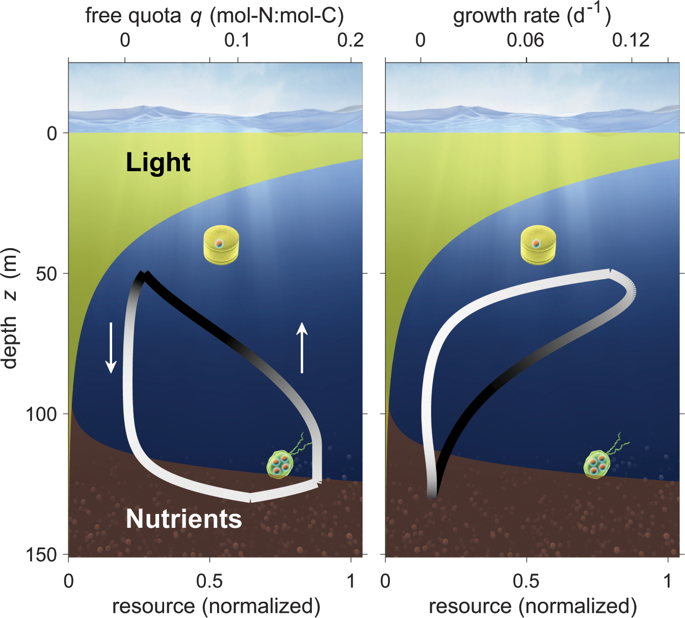Our official English website, www.x-mol.net, welcomes your
feedback! (Note: you will need to create a separate account there.)
Vertical migration by bulk phytoplankton sustains biodiversity and nutrient input to the surface ocean.
Scientific Reports ( IF 3.8 ) Pub Date : 2020-01-24 , DOI: 10.1038/s41598-020-57890-2 Kai Wirtz 1 , S Lan Smith 2
Scientific Reports ( IF 3.8 ) Pub Date : 2020-01-24 , DOI: 10.1038/s41598-020-57890-2 Kai Wirtz 1 , S Lan Smith 2
Affiliation

|
Phytoplankton subsumes the great variety of unicellular photoautotrophs that perform roughly half of Earth's primary production. They achieve this despite their challenging oceanic habitat, with opposing vertical gradients of nutrients (which often limit their growth near the surface) and light (which becomes limiting with increasing depth). Most phytoplankton species are commonly assumed to be incapable of moving actively between the zones of light and nutrient availability, which are separated vertically by from 30-120 m. Here we propose that a considerable fraction of phytoplankton vertically traverse these gradients over time scales from hours to weeks, employing variations of a common migration strategy to acquire multiple resources. We present a mechanistic Lagrangian model resolving phytoplankton growth linked to optimal migration behaviour and demonstrate unprecedented agreement of its calculated vertical CHL-a distributions with 773 profiles observed at five prominent marine time-series stations. Our simulations reveal that vertically cycling phytoplankton can pump up enough nutrient to sustain as much as half of oceanic Net Primary Production (NPP). Active locomotion is therefore a plausible mechanism enabling relatively high NPP in the oligotrophic surface ocean. Our simulations also predict similar fitness for a variety of very different migration strategies, which helps to explain the puzzling diversity of phytoplankton observed in the ocean.
中文翻译:

大量浮游植物的垂直迁移维持了生物多样性和向表层海洋的营养输入。
浮游植物包含种类繁多的单细胞光能自养生物,它们约占地球初级生产的一半。尽管它们的海洋栖息地具有挑战性,但它们实现了这一目标,营养物质(通常会限制它们在表面附近的生长)和光线(随着深度的增加而受到限制)的垂直梯度相反。大多数浮游植物物种通常被认为不能在光和养分可用性区域之间积极移动,这些区域垂直相隔 30-120 m。在这里,我们建议相当一部分浮游植物在从几小时到几周的时间尺度上垂直穿越这些梯度,采用常见迁移策略的变体来获取多种资源。我们提出了一个机械拉格朗日模型,解决了与最佳迁移行为相关的浮游植物生长,并证明了其计算的垂直 CHL-a 分布与在五个主要海洋时间序列站观察到的 773 个剖面的前所未有的一致性。我们的模拟表明,垂直循环的浮游植物可以提供足够的养分来维持海洋净初级生产 (NPP) 的一半。因此,主动运动是一种合理的机制,可以在贫营养表面海洋中实现相对较高的 NPP。我们的模拟还预测了各种非常不同的迁徙策略的相似适应性,这有助于解释在海洋中观察到的令人费解的浮游植物多样性。
更新日期:2020-01-24
中文翻译:

大量浮游植物的垂直迁移维持了生物多样性和向表层海洋的营养输入。
浮游植物包含种类繁多的单细胞光能自养生物,它们约占地球初级生产的一半。尽管它们的海洋栖息地具有挑战性,但它们实现了这一目标,营养物质(通常会限制它们在表面附近的生长)和光线(随着深度的增加而受到限制)的垂直梯度相反。大多数浮游植物物种通常被认为不能在光和养分可用性区域之间积极移动,这些区域垂直相隔 30-120 m。在这里,我们建议相当一部分浮游植物在从几小时到几周的时间尺度上垂直穿越这些梯度,采用常见迁移策略的变体来获取多种资源。我们提出了一个机械拉格朗日模型,解决了与最佳迁移行为相关的浮游植物生长,并证明了其计算的垂直 CHL-a 分布与在五个主要海洋时间序列站观察到的 773 个剖面的前所未有的一致性。我们的模拟表明,垂直循环的浮游植物可以提供足够的养分来维持海洋净初级生产 (NPP) 的一半。因此,主动运动是一种合理的机制,可以在贫营养表面海洋中实现相对较高的 NPP。我们的模拟还预测了各种非常不同的迁徙策略的相似适应性,这有助于解释在海洋中观察到的令人费解的浮游植物多样性。






























 京公网安备 11010802027423号
京公网安备 11010802027423号